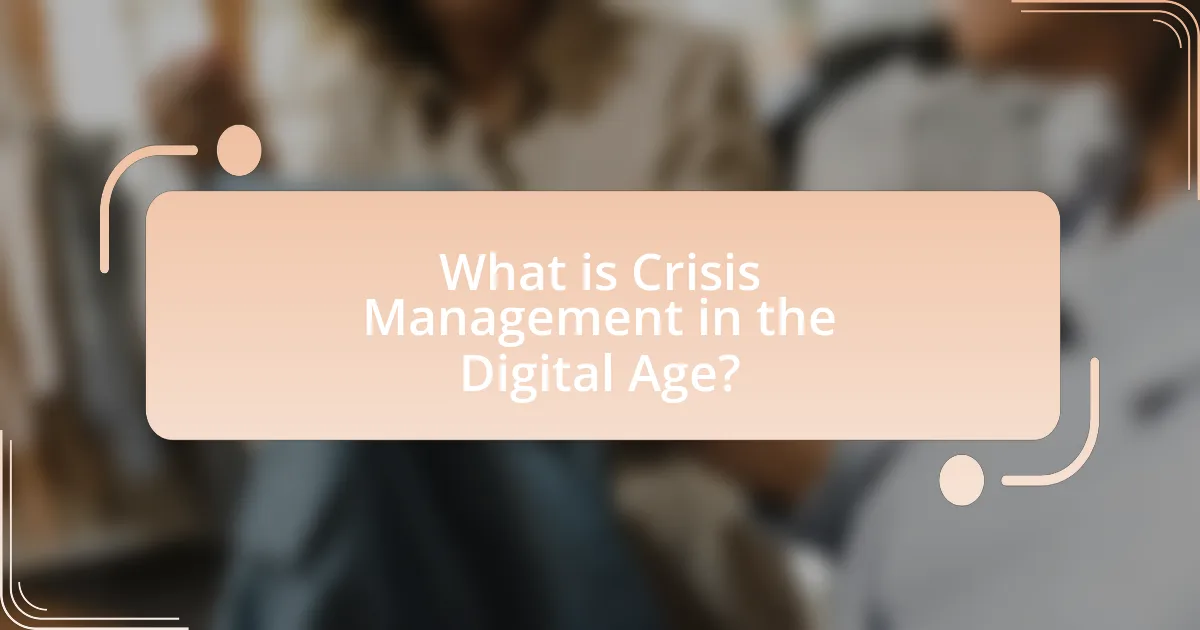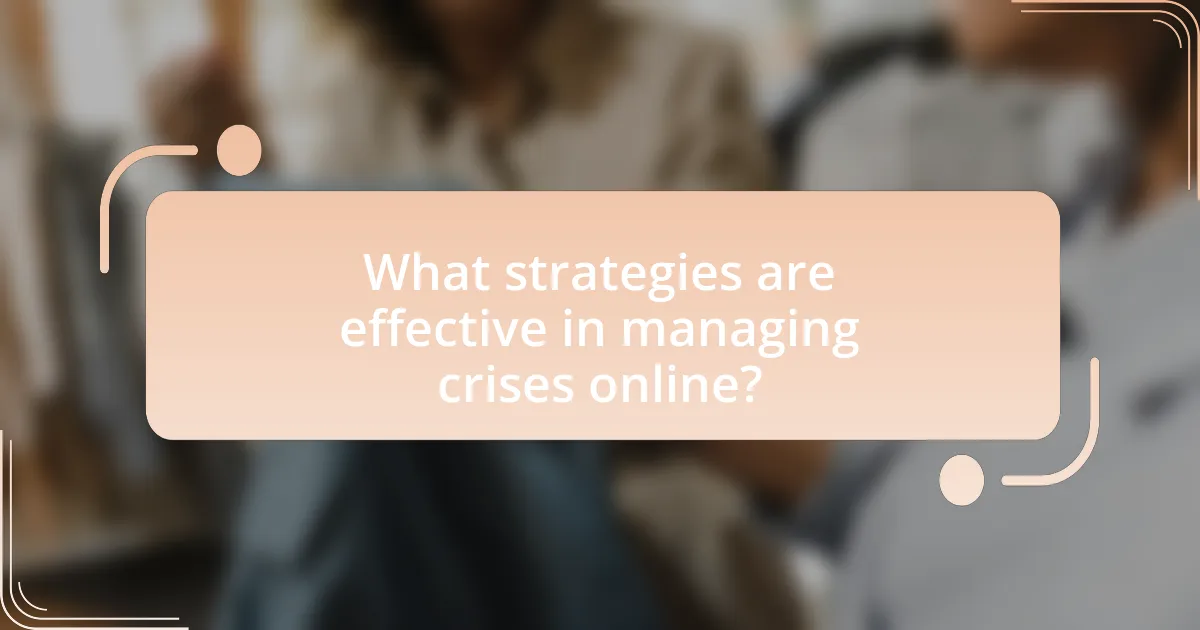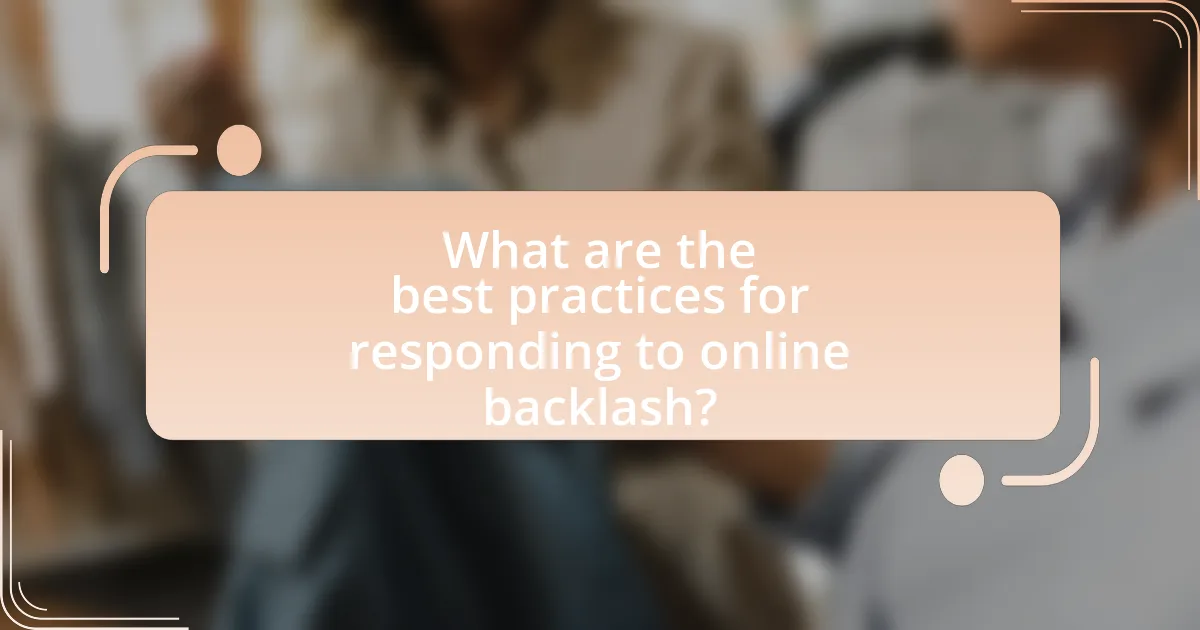Crisis management in the digital age encompasses the strategies organizations use to address and mitigate crises that arise in online environments, particularly focusing on social media backlash, misinformation, and reputational damage. The article outlines how the rise of digital platforms has transformed crisis management, emphasizing the need for real-time communication and proactive engagement with stakeholders. Key characteristics of digital crises include rapid information dissemination and high visibility, which can significantly influence public perception. Effective strategies for managing online backlash involve timely communication, transparency, and stakeholder engagement, while the article also highlights the importance of preparation, training, and the use of monitoring tools to enhance crisis response.

What is Crisis Management in the Digital Age?
Crisis management in the digital age refers to the strategies and practices organizations employ to address and mitigate the impact of crises that arise in online environments. This includes managing social media backlash, misinformation, and reputational damage that can escalate rapidly due to the instantaneous nature of digital communication. For instance, a study by the Harvard Business Review highlights that 70% of companies experience a crisis that escalates online, emphasizing the need for proactive digital strategies. Effective crisis management in this context involves real-time monitoring of online sentiment, swift communication responses, and transparent engagement with stakeholders to rebuild trust and maintain brand integrity.
How has the rise of digital platforms changed crisis management?
The rise of digital platforms has fundamentally transformed crisis management by enabling real-time communication and rapid dissemination of information. Organizations can now respond to crises more swiftly through social media and online channels, allowing them to address public concerns and misinformation almost instantaneously. For instance, during the COVID-19 pandemic, health organizations utilized platforms like Twitter and Facebook to provide timely updates, which significantly influenced public behavior and compliance with health guidelines. This shift has made it essential for crisis management strategies to incorporate digital engagement, as failure to do so can lead to escalated backlash and reputational damage.
What are the key characteristics of crises in the digital landscape?
Crises in the digital landscape are characterized by rapid information dissemination, high visibility, and the potential for widespread public engagement. The speed at which information spreads online can escalate a situation quickly, as seen in incidents like the United Airlines passenger removal in 2017, where video footage went viral within hours, leading to significant reputational damage. Additionally, the visibility of crises is amplified by social media platforms, allowing real-time reactions and discussions that can influence public perception. The interactive nature of digital platforms enables users to engage directly with brands, which can either mitigate or exacerbate the crisis depending on the response strategy employed.
How do social media dynamics influence crisis situations?
Social media dynamics significantly influence crisis situations by accelerating the spread of information and shaping public perception. During a crisis, platforms like Twitter and Facebook enable rapid dissemination of news, which can lead to immediate public reactions and mobilization. For instance, the 2017 United Airlines incident, where a passenger was forcibly removed from a flight, went viral on social media, resulting in widespread outrage and a swift corporate response. This illustrates how social media can amplify negative sentiments and pressure organizations to act quickly to mitigate reputational damage. Additionally, social media allows for real-time feedback, enabling organizations to gauge public sentiment and adjust their crisis management strategies accordingly.
Why is navigating online backlash crucial for organizations?
Navigating online backlash is crucial for organizations because it directly impacts their reputation and stakeholder trust. Effective management of negative online sentiment can prevent long-term damage to brand image and customer loyalty. For instance, a study by the Pew Research Center found that 70% of consumers are less likely to purchase from a brand that has faced public backlash without a proper response. Additionally, organizations that proactively address online criticism can mitigate the spread of misinformation and maintain a positive public perception, which is essential in today’s digital landscape where information spreads rapidly.
What are the potential consequences of failing to manage online backlash?
Failing to manage online backlash can lead to significant reputational damage for individuals or organizations. This damage often manifests as a loss of consumer trust, which can result in decreased sales and customer loyalty. For instance, a study by the Harvard Business Review found that companies experiencing negative online sentiment can see a drop in stock prices by up to 5% within a week of the backlash. Additionally, unaddressed backlash can escalate into larger crises, attracting media attention and further amplifying negative perceptions. Ultimately, the inability to effectively respond to online criticism can hinder long-term growth and sustainability.
How can online backlash impact brand reputation?
Online backlash can significantly damage brand reputation by leading to a loss of consumer trust and loyalty. When negative sentiments spread rapidly on social media or review platforms, they can create a perception of the brand as untrustworthy or unethical. For instance, a study by the Harvard Business Review found that brands experiencing online backlash can see a decline in sales by up to 20% within a few weeks of the incident. This decline is often accompanied by negative media coverage, which further amplifies the damage to the brand’s image. Additionally, the long-term effects can include a decrease in customer engagement and a tarnished public perception, making recovery more challenging.

What strategies are effective in managing crises online?
Effective strategies for managing crises online include timely communication, transparency, and active engagement with the audience. Timely communication ensures that information is disseminated quickly to counter misinformation and control the narrative. Transparency builds trust, as stakeholders appreciate honesty about the situation and the steps being taken to address it. Active engagement involves responding to inquiries and concerns from the audience, which can mitigate negative sentiment and foster a sense of community support. Research by the Institute for Public Relations indicates that organizations that communicate effectively during crises can reduce reputational damage and recover more swiftly.
How can organizations prepare for potential digital crises?
Organizations can prepare for potential digital crises by developing a comprehensive crisis management plan that includes proactive monitoring, clear communication strategies, and employee training. Proactive monitoring involves using tools to track online sentiment and identify potential issues before they escalate, as evidenced by a study from the Pew Research Center indicating that 70% of organizations that actively monitor social media can respond more effectively to crises. Clear communication strategies ensure that organizations convey consistent messages across all platforms, which is crucial during a crisis; research from the Institute for Public Relations shows that organizations with established communication plans are 50% more likely to maintain public trust. Employee training equips staff with the skills to handle crises effectively, as highlighted by a report from the Harvard Business Review, which found that organizations investing in crisis management training experience 30% less reputational damage during crises.
What role does a crisis communication plan play in digital crisis management?
A crisis communication plan is essential in digital crisis management as it provides a structured approach to addressing and mitigating the impact of negative events online. This plan outlines key messages, identifies spokespersons, and establishes protocols for timely communication, ensuring that organizations can respond swiftly and effectively to emerging crises. For instance, during the 2017 United Airlines incident, the absence of a clear crisis communication plan led to widespread backlash and reputational damage, highlighting the necessity of having a predefined strategy to manage public perception and maintain trust.
How can training and simulations enhance crisis preparedness?
Training and simulations enhance crisis preparedness by providing realistic scenarios that allow individuals and organizations to practice their response strategies. These methods enable participants to develop critical skills, such as decision-making and communication, under pressure. Research indicates that organizations that engage in regular crisis simulations experience a 30% improvement in response times during actual crises, as evidenced by a study conducted by the Harvard Business Review. This improvement is attributed to the familiarity gained through repeated practice, which helps teams coordinate effectively and reduces the likelihood of errors when facing real-world challenges.
What tools and technologies assist in crisis management?
Crisis management is supported by various tools and technologies, including social media monitoring platforms, crisis communication software, and data analytics tools. Social media monitoring platforms, such as Hootsuite and Brandwatch, enable organizations to track public sentiment and identify emerging issues in real-time. Crisis communication software, like Everbridge and OnSolve, facilitates efficient communication with stakeholders during a crisis, ensuring timely updates and information dissemination. Data analytics tools, including Google Analytics and Tableau, help organizations analyze data trends and assess the impact of a crisis on their operations. These technologies collectively enhance an organization’s ability to respond effectively to crises and manage online backlash.
Which social media monitoring tools are most effective?
The most effective social media monitoring tools include Hootsuite, Brandwatch, and Sprout Social. Hootsuite allows users to track multiple social media channels in one dashboard, providing real-time analytics and engagement metrics. Brandwatch excels in sentiment analysis and audience insights, enabling brands to understand public perception and respond accordingly. Sprout Social offers comprehensive reporting features and social listening capabilities, helping organizations manage their online reputation effectively. These tools are widely recognized for their ability to enhance crisis management strategies by providing actionable insights and facilitating timely responses to online backlash.
How can data analytics inform crisis response strategies?
Data analytics can inform crisis response strategies by providing real-time insights into public sentiment and behavior during a crisis. By analyzing social media data, news coverage, and other digital interactions, organizations can identify emerging issues, gauge public reactions, and tailor their communication strategies accordingly. For instance, a study by the Pew Research Center found that 69% of adults in the U.S. use social media, making it a critical platform for monitoring public opinion. This data-driven approach enables organizations to respond swiftly and effectively, mitigating potential backlash and enhancing their overall crisis management efforts.

What are the best practices for responding to online backlash?
The best practices for responding to online backlash include acknowledging the issue, providing a transparent explanation, and engaging with the audience. Acknowledging the issue demonstrates that the organization is aware of the concerns raised, which can help to de-escalate tensions. Providing a transparent explanation allows the audience to understand the context and reasoning behind the actions that led to the backlash. Engaging with the audience through direct communication, such as responding to comments or messages, fosters a sense of connection and shows that the organization values feedback. Research indicates that organizations that respond promptly and empathetically to online criticism can mitigate damage to their reputation and maintain customer loyalty.
How should organizations communicate during a crisis?
Organizations should communicate transparently and promptly during a crisis. Effective communication involves providing accurate information, addressing concerns, and maintaining a consistent message across all channels. Research indicates that organizations that communicate openly during crises can mitigate reputational damage and maintain stakeholder trust. For instance, a study by the Institute for Public Relations found that timely and transparent communication can lead to a 25% increase in public trust during crises. Therefore, organizations must prioritize clarity, empathy, and responsiveness in their crisis communication strategies.
What messaging strategies are most effective in mitigating backlash?
Effective messaging strategies for mitigating backlash include transparency, empathy, and timely communication. Transparency involves openly addressing the issue at hand, which builds trust and credibility with the audience. For instance, organizations that acknowledge mistakes and provide clear explanations tend to reduce negative sentiment. Empathy is crucial; expressing understanding of the audience’s feelings can foster connection and diffuse anger. Research shows that brands demonstrating empathy during crises experience a 20% decrease in negative perceptions. Timely communication ensures that the audience receives information promptly, preventing misinformation from spreading. A study by the Institute for Public Relations found that organizations that respond within the first hour of a crisis can reduce backlash by up to 50%. These strategies collectively enhance an organization’s ability to navigate online backlash effectively.
How can transparency and accountability influence public perception?
Transparency and accountability significantly enhance public perception by fostering trust and credibility. When organizations openly share information and take responsibility for their actions, they demonstrate integrity, which can mitigate negative sentiments during crises. For instance, a study by the Edelman Trust Barometer found that 81% of consumers need to trust a brand to buy from them, indicating that transparency directly correlates with consumer confidence. Furthermore, during crises, organizations that communicate transparently and accept accountability are perceived as more reliable, leading to improved public relations and reduced backlash.
What role does stakeholder engagement play in crisis management?
Stakeholder engagement is crucial in crisis management as it facilitates communication, builds trust, and fosters collaboration among all parties involved. Effective engagement allows organizations to understand stakeholder concerns, gather valuable feedback, and tailor responses that address specific issues, thereby mitigating potential backlash. For instance, during the 2017 United Airlines incident, the company’s failure to engage with stakeholders led to widespread criticism and damage to its reputation. Conversely, organizations that actively involve stakeholders in crisis response strategies can enhance their credibility and maintain public confidence, as seen in the case of Johnson & Johnson during the Tylenol crisis in 1982, where transparent communication and stakeholder involvement helped restore trust.
How can organizations effectively engage with their audience during a crisis?
Organizations can effectively engage with their audience during a crisis by maintaining transparent communication, providing timely updates, and actively listening to feedback. Transparent communication builds trust, as seen in the case of Johnson & Johnson during the Tylenol crisis in 1982, where their open dialogue with the public helped restore brand credibility. Timely updates keep the audience informed and reduce misinformation, which is crucial in fast-paced digital environments. Actively listening to feedback allows organizations to address concerns and adapt their strategies, as demonstrated by various companies that utilized social media platforms to gauge public sentiment and respond accordingly during crises.
What are the benefits of involving stakeholders in the crisis response process?
Involving stakeholders in the crisis response process enhances decision-making, fosters collaboration, and improves communication. Stakeholders bring diverse perspectives and expertise, which can lead to more effective solutions and strategies during a crisis. For instance, a study by the Harvard Business Review highlights that organizations that engage stakeholders during crises experience quicker recovery times and better reputational outcomes. Additionally, involving stakeholders can build trust and transparency, which are crucial for maintaining public confidence in the organization during challenging times.
What are the common pitfalls to avoid in digital crisis management?
Common pitfalls to avoid in digital crisis management include failing to respond promptly, not having a clear communication strategy, and neglecting to monitor social media channels. A delayed response can exacerbate the situation, as studies show that 53% of consumers expect brands to respond to their complaints within an hour. Without a clear communication strategy, organizations risk sending mixed messages, which can confuse stakeholders and damage credibility. Additionally, neglecting social media monitoring can lead to missed opportunities to address misinformation or negative sentiment, as 78% of consumers expect brands to be active on social platforms during a crisis.
How can organizations prevent miscommunication during a crisis?
Organizations can prevent miscommunication during a crisis by establishing clear communication protocols and utilizing multiple channels for information dissemination. Clear protocols ensure that all team members understand their roles and responsibilities, which minimizes confusion. Utilizing various channels, such as social media, email, and press releases, allows organizations to reach diverse audiences effectively. Research indicates that organizations with a structured communication plan are 50% more likely to manage crises successfully, as they can provide timely and accurate information to stakeholders, thereby reducing the risk of misinformation.
What mistakes can exacerbate online backlash?
Mistakes that can exacerbate online backlash include failing to acknowledge mistakes, providing inadequate responses, and ignoring the concerns of the audience. When organizations do not admit to errors, they appear untrustworthy, which can intensify negative sentiment. For instance, the 2017 United Airlines incident, where a passenger was forcibly removed, escalated backlash due to the company’s initial silence and lack of accountability. Additionally, vague or dismissive responses can frustrate audiences, leading to further outrage, as seen in various corporate scandals where insufficient communication failed to address public concerns. Ignoring audience feedback can alienate stakeholders, resulting in a loss of support and increased criticism, as evidenced by brands that have faced boycotts after disregarding consumer opinions.
What practical tips can organizations implement for effective crisis management?
Organizations can implement several practical tips for effective crisis management, including establishing a crisis communication plan, training staff on crisis response, and utilizing social media monitoring tools. A crisis communication plan ensures that all stakeholders receive timely and accurate information, which is crucial during a crisis. Training staff prepares them to respond quickly and effectively, reducing confusion and misinformation. Social media monitoring tools allow organizations to track public sentiment and respond to online backlash in real-time, which is essential in the digital age where information spreads rapidly. These strategies are supported by research indicating that organizations with a proactive crisis management approach can mitigate damage and recover more quickly from adverse events.